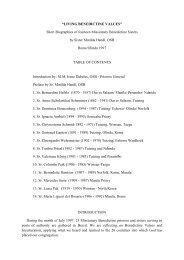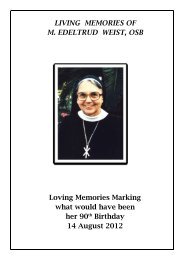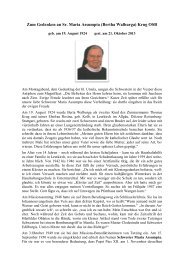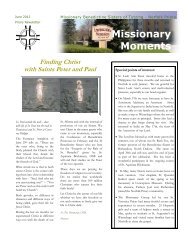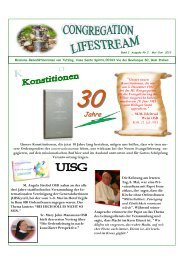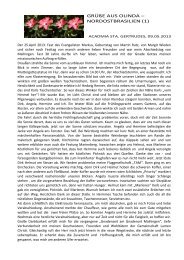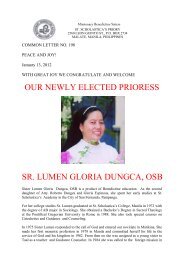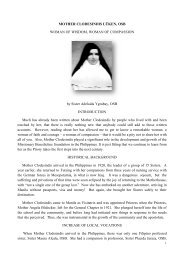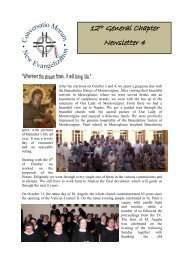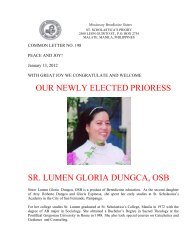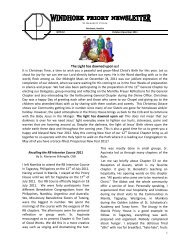biography of sr. reinolda may osb - Welcome to the Missionary ...
biography of sr. reinolda may osb - Welcome to the Missionary ...
biography of sr. reinolda may osb - Welcome to the Missionary ...
You also want an ePaper? Increase the reach of your titles
YUMPU automatically turns print PDFs into web optimized ePapers that Google loves.
BIOGRAPHY OF<br />
SR. REINOLDA MAY OSB<br />
CHILDHOOD AND YOUTH<br />
Sr. Reinolda May was born in<strong>to</strong> a religious family on 21 Oc<strong>to</strong>ber 1901 at Pfahlheim near<br />
Ellwangen in <strong>the</strong> diocese <strong>of</strong> Rottenburg in south-western Germany. The following day<br />
she was baptized and given <strong>the</strong> name Francisca. Her fa<strong>the</strong>r John Baptist May was a<br />
shoemaker and small farmer, and Francisca was <strong>the</strong> youngest <strong>of</strong> nine children. Three<br />
children had died a few months after birth. Her mo<strong>the</strong>r Magdalena (nee Rathgeb)<br />
brought two children in<strong>to</strong> <strong>the</strong> first marriage. After <strong>the</strong> death <strong>of</strong> her first husband, Joseph<br />
Kling, she married again in 1895. Francisca completed her primary education in her<br />
home village. She helped out at home and later attended <strong>the</strong> domestic school <strong>of</strong> <strong>the</strong><br />
Franciscan sisters <strong>of</strong> Dillingen at Hochaltingen in Bavaria.<br />
The village <strong>of</strong> Pfahlheim had a very zealous priest at<br />
that time and he made every effort <strong>to</strong> get his<br />
parishioners actively involved in one or ano<strong>the</strong>r <strong>of</strong> <strong>the</strong><br />
Catholic sodalities. Young and old, men and women,<br />
<strong>the</strong> married and <strong>the</strong> unmarried were thus constantly<br />
encouraged <strong>to</strong> practice <strong>the</strong>ir faith. Each group had a<br />
special Sunday set aside when its members would<br />
receive Communion. A whole range <strong>of</strong> colourful<br />
cus<strong>to</strong>ms enhanced <strong>the</strong> great liturgical celebrations <strong>of</strong><br />
<strong>the</strong> church year. The parish priest promoted church<br />
music. He fostered a Eucharistic spirituality through<br />
daily Holy Mass and Eucharistic devotions. “When I as<br />
a child was preparing for my first Holy Communion”,<br />
Sr. Reinolda remarked many years afterwards, “Our<br />
parish priest implanted a love for Jesus in <strong>the</strong> Holy<br />
1
Eucharist.” Fr. Eugen Adis was inspired by <strong>the</strong> programme <strong>of</strong> <strong>the</strong> pontificate <strong>of</strong> Pope<br />
Pius X. (1903 – 1914) “To renew all things in Christ”.<br />
In her youth Sr. Reinolda learned <strong>to</strong> love Mary, <strong>the</strong> Mo<strong>the</strong>r<br />
<strong>of</strong> God. The girl Francisca joined <strong>the</strong> parish sodality <strong>of</strong> Our<br />
Lady, which had more than 100 members. The sodality<br />
wakened in <strong>the</strong> hearts <strong>of</strong> its members a real love and<br />
devotion for <strong>the</strong> Blessed Virgin Mary. In fact, <strong>the</strong> sodality<br />
fostered and protected this love, guiding its members <strong>to</strong> live<br />
as children <strong>of</strong> Mary and <strong>to</strong> serve God through leading a<br />
Christian life. They were encouraged <strong>to</strong> fight <strong>to</strong>ge<strong>the</strong>r<br />
against <strong>the</strong> enemy <strong>of</strong> <strong>the</strong>ir faith and chastity and <strong>to</strong> support<br />
<strong>the</strong> work <strong>of</strong> Jesus and his church. Every evening <strong>the</strong><br />
Blessed Sacrament was exposed and <strong>the</strong> rosary was said<br />
in <strong>the</strong> parish church. Many parishioners <strong>to</strong>ok part in <strong>the</strong><br />
annual pilgrimage on foot <strong>to</strong> <strong>the</strong> wonderful Marian Shrine<br />
Schoenenberg.<br />
A few Sisters <strong>of</strong> St. Vincent de Paul <strong>of</strong> Untermarchtal cared for <strong>the</strong> children and <strong>the</strong> sick<br />
in <strong>the</strong> community. They were at <strong>the</strong> service <strong>of</strong> <strong>the</strong> sodalities and <strong>the</strong> parish church. The<br />
community appreciated <strong>the</strong>ir devoted work.<br />
It is not surprising that such an environment produced a good number <strong>of</strong> religious<br />
vocations. Although <strong>the</strong>re were only about one thousand Catholics in <strong>the</strong> parish <strong>of</strong><br />
Pfahlheim at <strong>the</strong> turn <strong>of</strong> <strong>the</strong> 20 th Century, more than thirty girls joined twelve different<br />
congregations <strong>of</strong> sisters while Fr. Eugen Adis was <strong>the</strong> parish priest from 1910 <strong>to</strong> 1938.<br />
One <strong>of</strong> <strong>the</strong>m was Francisca May.<br />
SR. REINOLDA’S EARLY YEARS AS MISSIONARY BENEDICTINE SISTER<br />
Francisca May showed a keen interest in <strong>the</strong> missions. Her parish priest advised her <strong>to</strong><br />
join <strong>the</strong> <strong>Missionary</strong> Benedictine Sisters <strong>of</strong> Tutzing.<br />
Towards <strong>the</strong> end <strong>of</strong> <strong>the</strong> nineteenth century Fr. Andreas Amrhein OSB had founded <strong>the</strong><br />
<strong>Missionary</strong> Benedictines <strong>of</strong> St. Ottilien and <strong>the</strong> <strong>Missionary</strong> Benedictine Sisters <strong>of</strong><br />
Tutzing. In <strong>the</strong> very early days <strong>of</strong> <strong>the</strong> Congregation <strong>of</strong> <strong>the</strong> <strong>Missionary</strong> Benedictine Sisters<br />
solid foundations <strong>of</strong> <strong>the</strong> congregation had been laid. The founder wanted <strong>to</strong> form his<br />
bro<strong>the</strong>rs and sisters by <strong>the</strong> Rule <strong>of</strong> Benedict and according <strong>to</strong> <strong>the</strong> Benedictine tradition<br />
for doing God’s work, “for God and <strong>the</strong> salvation <strong>of</strong> souls” in <strong>the</strong> <strong>to</strong>il and sacrifices <strong>of</strong> <strong>the</strong><br />
missionary vocation.<br />
Sr. Birgitta Korff was <strong>the</strong> first Prioress General <strong>of</strong> <strong>the</strong> young congregation from 1895 <strong>to</strong><br />
1920.After she had been reelected in 1903 she wrote a letter <strong>to</strong> her sisters in East<br />
Africa: “The salvation <strong>of</strong> souls is not <strong>the</strong> work <strong>of</strong> weak human beings. No, it is God’s<br />
work. But <strong>the</strong> Lord wants us <strong>to</strong> share in His work… How much sacrifice, self denial and<br />
struggle is demanded by constant faithfulness in little things! If we feel <strong>to</strong>o sluggish,<br />
weak and lacking energy for diligent striving, oh, let us go <strong>to</strong> <strong>the</strong> Divine Heart <strong>of</strong> Jesus in<br />
<strong>the</strong> tabernacle <strong>to</strong> obtain <strong>the</strong> fervor which imparts strength.” Bro<strong>the</strong>rs and sisters,<br />
members <strong>of</strong> <strong>the</strong> same spiritual family, formed by <strong>the</strong> same Benedictine Rule, struggled<br />
<strong>to</strong> live <strong>the</strong>ir missionary vocation and experienced God’s faithfulness.<br />
2
Francisca’s first attempt at Tutzing failed.<br />
She was <strong>to</strong>ld that she was not healthy<br />
enough <strong>to</strong> go <strong>to</strong> <strong>the</strong> missions, so Francisca<br />
was forced <strong>to</strong> return <strong>to</strong> her family. Her<br />
fa<strong>the</strong>r was not at all sad about this turn <strong>of</strong><br />
events. He loved his youngest daughter<br />
who was charming and full <strong>of</strong> life.<br />
Francisca’s thoughts however were firmly<br />
fixed on becoming a missionary. People<br />
remembered that she was <strong>the</strong>n frequently<br />
seen during <strong>the</strong> day praying in <strong>the</strong> parish church. This must have struck <strong>the</strong> villagers as<br />
somewhat unusual. O<strong>the</strong>rwise <strong>the</strong>y would not have taken any notice. Francisca travelled<br />
once more <strong>to</strong> Tutzing. She tried a second time <strong>to</strong> answer God’s call. On 1 st March 1922,<br />
she entered <strong>the</strong> Congregation <strong>of</strong> <strong>the</strong> <strong>Missionary</strong> Benedictine Sisters at Tutzing and her<br />
religious pr<strong>of</strong>ession <strong>to</strong>ok place at <strong>the</strong> feast <strong>of</strong> St. Scholastica on 10 th February 1925.<br />
She <strong>to</strong>ok <strong>the</strong> name <strong>of</strong> Sr. Reinolda. The young sister was assigned <strong>to</strong> dedicate her life<br />
<strong>to</strong> missionary work in Zululand, South Africa.<br />
The Apos<strong>to</strong>lic Vicariate <strong>of</strong> Zululand had been mandated <strong>to</strong> <strong>the</strong> <strong>Missionary</strong> Benedictines<br />
<strong>of</strong> St. Ottilien only in 1922.<br />
The Pioneers, Fr. Thomas Spreiter OSB, former Vicar Apos<strong>to</strong>lic <strong>of</strong> Dar-es Salaam, and<br />
his confreres had all previously worked in <strong>the</strong> East African mission field. It was as a<br />
result <strong>of</strong> <strong>the</strong> First World War that <strong>the</strong>y had <strong>to</strong> leave East Africa. They were <strong>of</strong>fered new<br />
missionary terri<strong>to</strong>ry in South Africa. The <strong>Missionary</strong> Benedictines started <strong>the</strong>ir<br />
missionary work at Inkamana, near Vryheid in Natal, in August 1922.<br />
Bishop Spreiter wanted <strong>the</strong> <strong>Missionary</strong> Benedictine Sisters <strong>to</strong> work once more for him.<br />
They <strong>to</strong>o had <strong>to</strong> leave East Africa and had come <strong>to</strong> South Africa. Two Tutzing Sisters<br />
were <strong>the</strong> first <strong>to</strong> arrive at Inkamana in December 1922. Bishop Spreiter was pleased that<br />
<strong>the</strong> Benedictine Sisters <strong>of</strong> Tutzing were assisting him once again. He had a very high<br />
opinion <strong>of</strong> <strong>the</strong>m. They were exemplary as religious, unwavering in <strong>the</strong>ir commitment <strong>to</strong><br />
missionary apos<strong>to</strong>late, highly disciplined and always willing <strong>to</strong> bear <strong>the</strong> hardships <strong>of</strong> a<br />
new beginning. A remark in his diary illustrates his esteem <strong>of</strong> <strong>the</strong> sisters: “I regard <strong>the</strong>m<br />
really as sisters, as precious coworkers.”<br />
On Sunday morning, 21June1925 Sr. Reinolda received <strong>the</strong> mission cross. In <strong>the</strong> early<br />
afternoon she left <strong>the</strong> mo<strong>the</strong>rhouse at Tutzing. In Hamburg she embarked <strong>to</strong>ge<strong>the</strong>r with<br />
three sisters for Zululand. In her letter from Antwerp, Belgium, bearing <strong>the</strong> date <strong>of</strong> June<br />
26, 1925 she writes <strong>to</strong> her “dear parents and all loved ones”: “Leaving German soil did<br />
not impress me at all. It didn’t cause <strong>the</strong> slightest pain. Now all bonds are loosened.<br />
Home, Mo<strong>the</strong>rhouse, Fa<strong>the</strong>rland! – I was however not insensitive <strong>to</strong> leaving home and<br />
mo<strong>the</strong>rhouse. In all <strong>the</strong> sacrifices I felt unspeakable peace and happiness. Never before<br />
could I pray sincerely: ‘Jesus, all for you alone’ – “Your happy missionary sister, Sr.<br />
Reinolda OSB. “<br />
The first Christian missionaries came <strong>to</strong> Zululand in <strong>the</strong> middle <strong>of</strong> <strong>the</strong> 19 th century. The<br />
Lu<strong>the</strong>ran Church and <strong>the</strong> Anglican Church founded mission stations. Zululand was part<br />
<strong>of</strong> <strong>the</strong> Vicariate Apos<strong>to</strong>lic <strong>of</strong> Natal which was erected in 1850 and entrusted <strong>to</strong> <strong>the</strong><br />
Oblates <strong>of</strong> Mary Immaculate. In 1895 Bishop Jolivet <strong>of</strong> Durban assigned Oblates <strong>to</strong> go<br />
3
<strong>to</strong> Zululand. The Emoyeni Mission was opened. Before Christmas 1895, three<br />
Dominican Sisters <strong>of</strong> Oakford arrived at Emoyeni/Holy Cross. A second Catholic Mission<br />
was started at Mbongolwane in 1914. French Franciscan nuns supported <strong>the</strong> Oblates.<br />
The Benedictine missionaries <strong>to</strong>ok over Emoyeni and Mbongolwane mission in 1924.<br />
In her early years as a missionary in Zululand Sr. Reinolda worked as seamstress at<br />
<strong>the</strong>se mission stations. She made a great effort <strong>to</strong> learn <strong>the</strong> difficult Zulu language. Soon<br />
she began her mission work in <strong>the</strong> homes <strong>of</strong> <strong>the</strong> Zulus. As much as time permitted, she<br />
visited people on foot and on horseback. Sisters on horseback were a common sight in<br />
those pioneering days.<br />
A new Vocation<br />
THE DEDICATED MIDWIFE<br />
Bishop Thomas Spreiter at that time was convinced <strong>of</strong> <strong>the</strong> great importance <strong>of</strong> indirect<br />
mission work in school and hospital for <strong>the</strong> spreading <strong>of</strong> <strong>the</strong> faith in a difficult mission<br />
terri<strong>to</strong>ry like South Africa. With great vision and courage he worked <strong>to</strong> obtain permission<br />
from Rome that Benedictine Sisters could be trained in midwifery.<br />
After years <strong>of</strong> persistent effort this<br />
permission was obtained from Rome<br />
and from Tutzing in 1936. The sisters<br />
in Zululand were allowed <strong>to</strong> assist<br />
women in childbirth. Sr. Reinolda<br />
became <strong>the</strong> first sister <strong>to</strong> take a course<br />
in midwifery. She had been asked by<br />
her superiors if she wanted <strong>to</strong> take this<br />
training. When she was requested <strong>to</strong><br />
enroll for <strong>the</strong> midwifery course she<br />
seemed <strong>to</strong> be a ra<strong>the</strong>r unlikely<br />
candidate as she was already in her<br />
mid thirties, and lacked secondary<br />
education. Moreover her knowledge <strong>of</strong><br />
English was scant and she had spent<br />
all <strong>of</strong> her missionary years in <strong>the</strong> sewing room. She soon agreed, trusting in God’s help<br />
and in view <strong>of</strong> <strong>the</strong> personnel needs <strong>of</strong> <strong>the</strong> hospital at Nongoma that was under<br />
construction. Her decision was entirely borne by her spirit <strong>of</strong> faith. A young Dominican<br />
sister also trained as midwife at that time in Pietermaritzburg.<br />
Because <strong>of</strong> her knowledge <strong>of</strong> <strong>the</strong> language and academic ability, <strong>the</strong> sister had better<br />
chances for successful final exam. Sr. Reinolda also studied hard, but not through many<br />
nights in order not <strong>to</strong> neglect her spiritual life. She relied completely on God in prayer, a<br />
spirit <strong>of</strong> faith and trust in God. In <strong>the</strong> end she received a better mark in <strong>the</strong> final exam<br />
than this Dominican Sister. In May <strong>of</strong> 1938, Sr. Reinolda passed her exams and was<br />
awarded a diploma as midwife from Grey’s hospital in Pietermaritzburg.<br />
4
Start at Nongoma<br />
The fourth Catholic Mission Station at<br />
Nongoma in Zululand was founded by<br />
<strong>the</strong> Benedictines on August 1, 1926.<br />
Nongoma is <strong>the</strong> royal city <strong>of</strong> Zululand,<br />
<strong>the</strong> home <strong>of</strong> <strong>the</strong> Zulu king. The Catholic<br />
mission station was dedicated <strong>to</strong> Christ<br />
<strong>the</strong> King.<br />
When <strong>the</strong> Benedictine Mission Hospital<br />
at Nongoma opened in June 1938, <strong>the</strong><br />
newly qualified Sr. Reinolda was put in<br />
charge <strong>of</strong> <strong>the</strong> maternity section.<br />
At first, things were difficult: She experienced personal hardships and great poverty, she<br />
had <strong>to</strong> put up with <strong>the</strong> distrust <strong>of</strong> <strong>the</strong> local population, not <strong>to</strong> mention quarrels with <strong>the</strong><br />
district surgeon who did all he could <strong>to</strong> harm <strong>the</strong> competi<strong>to</strong>r, as he perceived it. In <strong>the</strong>se<br />
years Sr. Reinolda’s great union with God and her deep faith became evident. She<br />
spent many an hour <strong>of</strong> <strong>the</strong> night in prayer in order <strong>to</strong> be able <strong>to</strong> handle <strong>the</strong>se difficulties.<br />
Yet, as time passed, she slowly won <strong>the</strong> hearts <strong>of</strong> <strong>the</strong> Zulus by her kindness and<br />
generous readiness <strong>to</strong> help. In addition, her expertise as midwife soon attracted mo<strong>the</strong>rs<br />
from afar<br />
Training <strong>of</strong> midwives<br />
Eventually, Sr. Reinolda began in turn <strong>to</strong> train midwives. In 1941 <strong>the</strong> first group <strong>to</strong>ok<br />
<strong>the</strong>ir exams. Hundreds <strong>of</strong> young Zulu girls, black and white religious sisters <strong>of</strong> various<br />
congregations as well as her own fellow sisters were her pupils. They trained under her<br />
vigilant and highly capable supervision.<br />
Her nurses knew discipline and were always punctual at work, attending classes and<br />
<strong>the</strong>y all knew what was expected <strong>of</strong> <strong>the</strong>m. Her lectures were very practical. She talked<br />
about sexual life in an unusually relaxed way. She was able <strong>to</strong> train students who were<br />
not talented. In all <strong>the</strong>se years she had a 100% pass rate.<br />
Sr. Reinolda was strict but kind. She did not hesitate <strong>to</strong> correct firmly but always in a<br />
kind way. One could very <strong>of</strong>ten find her at her patients’ bedsides. In this way she taught<br />
her student midwives <strong>to</strong> do <strong>the</strong> same. She tried very hard <strong>to</strong> bring <strong>the</strong> nurses <strong>to</strong><br />
understand <strong>the</strong> quality <strong>of</strong> nursing care.<br />
Midwifery is a complicated field <strong>of</strong> nursing as <strong>the</strong> midwife has <strong>to</strong> act promptly when<br />
complication arises. She successfully taught her nurses what <strong>to</strong> do. She empowered her<br />
nurses for such skills. The midwives would do all what <strong>the</strong>y can without her, but when<br />
<strong>the</strong> labour was a difficult one a beep was heard from <strong>the</strong> maternity section. Everyone<br />
knew that this was an emergency call for Sr. Reinolda. Always ready, she hurried <strong>to</strong> give<br />
council in a difficult situation or <strong>to</strong> do <strong>the</strong> work herself. The doc<strong>to</strong>rs appreciated her<br />
knowledge and skills and were not shy <strong>to</strong> learn from her long experience.<br />
5
Nurse and Mo<strong>the</strong>r<br />
This true nurse had <strong>the</strong> heart <strong>of</strong> a mo<strong>the</strong>r. She was <strong>the</strong> one constant fac<strong>to</strong>r in <strong>the</strong><br />
maternity department. Her <strong>of</strong>fice and bedroom was in <strong>the</strong> maternity section. She was on<br />
duty for 24 hours. When a woman had a difficult labour and <strong>the</strong> baby was crying<br />
throughout <strong>the</strong> night Sr. Reinolda became a babysitter during <strong>the</strong> whole night. One<br />
could see her going up and down <strong>the</strong> corridor holding babies close <strong>to</strong> her heart. She<br />
would follow closely <strong>the</strong> progress <strong>of</strong> a mo<strong>the</strong>r and a baby until <strong>the</strong>y were discharged in a<br />
healthy condition.<br />
She went out on foot or donkey cart visiting expectant mo<strong>the</strong>rs in <strong>the</strong> rural area. If sister<br />
was called upon at night she would get up and go on a donkey cart with a hurricane<br />
lamp. She would take <strong>the</strong> mo<strong>the</strong>r <strong>to</strong> <strong>the</strong> hospital. Sr. Reinolda showed great love<br />
<strong>to</strong>wards <strong>the</strong> expectant mo<strong>the</strong>rs. She attended <strong>the</strong>m in <strong>the</strong>ir huts <strong>to</strong> <strong>the</strong> best <strong>of</strong> her ability.<br />
A Benedictine sister who trained at <strong>the</strong> maternity department and worked <strong>the</strong>re for 20<br />
years remarked: “Sr. Reinolda was attentive and concerned about all <strong>the</strong> people in <strong>the</strong><br />
maternity ward. She loved all <strong>the</strong> patients, babies and mo<strong>the</strong>rs and cared for <strong>the</strong>m as<br />
only a good and self-forgetting mo<strong>the</strong>r can do.”<br />
The nurses who had been <strong>to</strong>ge<strong>the</strong>r with Sr. Reinolda in <strong>the</strong> maternity department got <strong>to</strong><br />
know her well. They respected, admired and loved her. They learned from her <strong>the</strong><br />
Christian way <strong>of</strong> living. Sr. Reinolda prayed wholeheartedly for her nurses.<br />
.<br />
THE ZEALOUS MISSIONARY<br />
Woman <strong>of</strong> charity<br />
It was not only her reputation as midwife<br />
that made her so popular in <strong>the</strong> district but<br />
more particularly her keen and sincere<br />
interest in <strong>the</strong> welfare <strong>of</strong> <strong>the</strong> people. Sr.<br />
Reinolda had her heart in her missionary<br />
vocation. She longed <strong>to</strong> bring <strong>the</strong> love <strong>of</strong><br />
Christ <strong>to</strong> his people in Zululand. She knew<br />
that charity is <strong>the</strong> soul <strong>of</strong> <strong>the</strong> missionary<br />
apos<strong>to</strong>late.<br />
Day after day she came <strong>to</strong> <strong>the</strong> aid <strong>of</strong><br />
people she met in and outside <strong>the</strong> hospital.<br />
She visited <strong>the</strong> sick in <strong>the</strong> different wards <strong>of</strong><br />
<strong>the</strong> hospital and comforted <strong>the</strong>m. Poor and hungry people came <strong>to</strong> her door. She gave<br />
<strong>the</strong>m food and clo<strong>the</strong>d <strong>the</strong>m. With priests and bro<strong>the</strong>rs she went out in order <strong>to</strong> get a<br />
chance <strong>of</strong> visiting sick people in <strong>the</strong>ir homes. The poor, unwanted as well as families<br />
with many children received her special care. Through all <strong>the</strong> years, generous<br />
benefac<strong>to</strong>rs overseas supported her charitable mission.<br />
6
At <strong>the</strong> same time Jesus whom she loved so much was on her lips. She brought <strong>the</strong><br />
Good News <strong>to</strong> people <strong>to</strong>ge<strong>the</strong>r with medicine, food and clothing. Praying <strong>to</strong>ge<strong>the</strong>r with<br />
people in <strong>the</strong>ir homes was <strong>the</strong> central part <strong>of</strong> her missionary endeavor. People could not<br />
forget <strong>the</strong> way she prayed in <strong>the</strong>ir midst. She did not s<strong>to</strong>p doing good even if her<br />
kindness was occasionally misused.<br />
Co-worker/ Co-missionary<br />
The flame <strong>of</strong> an unusual missionary zeal flickered in <strong>the</strong> soul <strong>of</strong> Sr. Reinolda. Her comissionaries<br />
experienced her as a very solid missionary sister in <strong>the</strong> truest sense <strong>of</strong> <strong>the</strong><br />
word.<br />
As a responsible and efficient midwife she came in contact with many people, women<br />
and men from near and far, and she enjoyed <strong>the</strong>ir complete confidence. In her friendly<br />
manner combined with zeal for souls she had a great moral influence on those who<br />
sought her help. If she met with cases that required a priest, she informed him and sent<br />
<strong>the</strong> persons <strong>to</strong> <strong>the</strong> priest. Many non-practicing Christians found <strong>the</strong>ir way back <strong>to</strong> <strong>the</strong><br />
church. In marriage situations where <strong>the</strong> Catholic man or catechumen lived <strong>to</strong>ge<strong>the</strong>r<br />
with several wives, she managed <strong>to</strong> convince <strong>the</strong> man <strong>to</strong> enter a church marriage with<br />
one <strong>of</strong> <strong>the</strong>m and separate – again without harshness - from <strong>the</strong> o<strong>the</strong>rs and thus start a<br />
Christian family. During her pas<strong>to</strong>ral visits in <strong>the</strong> wide-spread Nongoma parish, <strong>of</strong>ten<br />
<strong>to</strong>ge<strong>the</strong>r with <strong>the</strong> priest, Sr. Reinolda taught people <strong>the</strong> Christian faith in word and deed.<br />
At home, in <strong>the</strong> hospital and outside one would see her mixing with people, talking <strong>to</strong><br />
<strong>the</strong>m, laughing and at times giving <strong>the</strong>m “Holy Pictures” and asking <strong>the</strong>m about going <strong>to</strong><br />
church. There was hardly a woman who would leave <strong>the</strong> maternity ward without a holy<br />
picture from her.<br />
Over <strong>the</strong> many years Sr. Reinolda lived and worked in <strong>the</strong> maternity department many<br />
babies who were in mortal danger received emergency baptism and all <strong>the</strong> children who<br />
survived were not forgotten by Sr. Reinolda. She made every effort <strong>to</strong> track down <strong>the</strong>se<br />
children and admonished <strong>the</strong> parents <strong>to</strong> have <strong>the</strong>se children educated in a Catholic<br />
school. She invited <strong>the</strong>ir families <strong>to</strong> attend Catholic Church services.<br />
One beautiful aspect <strong>of</strong> her missionary zeal was her fostering <strong>of</strong> priestly vocations.<br />
Wherever she saw talents in a boy, she made every effort <strong>to</strong> enable him <strong>to</strong> go on <strong>to</strong><br />
higher education. Even if she experienced many a disappointment, she did not get<br />
discouraged. Young men who were preparing for priesthood could rely on her support<br />
and prayer. More than one reached his goal.<br />
“Mashiane”<br />
Sr. Reinolda was a well known nun among <strong>the</strong> sick, nurses, doc<strong>to</strong>rs, poor, orphans,<br />
Christians, non-Christians and <strong>the</strong> community at large especially <strong>the</strong> pregnant women<br />
and those who had delivered <strong>the</strong>ir babies at <strong>the</strong> Benedictine Hospital. The community<br />
nicknamed her “Mashiane” on account <strong>of</strong> her thick eyebrows. This name was well<br />
accepted by sisters, priests, bro<strong>the</strong>rs and by everybody who worked at <strong>the</strong> Benedictine<br />
Hospital. According <strong>to</strong> Zulu tradition, when a bride is accepted by in-laws especially on<br />
<strong>the</strong> wedding day, she is given a name as a sign that she is one <strong>of</strong> <strong>the</strong> family members<br />
7
and <strong>the</strong> clan. Sr. Reinolda was given a name by<br />
<strong>the</strong> community as a sign <strong>of</strong> acceptance by <strong>the</strong><br />
community.<br />
Mashiane was known and loved everywhere in<br />
<strong>the</strong> Nongoma region, and her word counted.<br />
Even <strong>the</strong> Zulu king, who was born in her<br />
department, came occasionally <strong>to</strong> her small<br />
<strong>of</strong>fice for advice. She was most welcome in <strong>the</strong><br />
royal family.<br />
The Benedictine Sister<br />
Sr. Reinolda loved her religious community. She gladly joined <strong>the</strong>m in <strong>the</strong> celebration <strong>of</strong><br />
<strong>the</strong> Divine Office and <strong>the</strong> Holy Eucharist. She firmly believed that she was called by God<br />
<strong>to</strong> be a woman <strong>of</strong> prayer in <strong>the</strong> community. “The Work <strong>of</strong> God” should always retain its<br />
primary position for <strong>the</strong> Benedictine community.<br />
“Nothing is <strong>to</strong> be preferred <strong>to</strong> <strong>the</strong> Work <strong>of</strong> God.” (Rule <strong>of</strong> Benedict)<br />
In urgent cases <strong>the</strong> service <strong>of</strong> mo<strong>the</strong>rs and babies was <strong>to</strong> be preferred <strong>to</strong> all else, and <strong>to</strong><br />
be performed without delay. Sr. Reinolda believed that service <strong>of</strong> o<strong>the</strong>rs is service <strong>of</strong><br />
God. Whenever possible Sr. Reinolda <strong>to</strong>ok part in <strong>the</strong> common meals and enjoyed <strong>the</strong><br />
company <strong>of</strong> her sisters at recreation time. All <strong>the</strong> sisters were eager listeners when Sr.<br />
Reinolda related <strong>to</strong> <strong>the</strong>m about her work and experience as a missionary. Then it would<br />
happen that nobody else had a chance <strong>to</strong> speak during recreation time. Whenever<br />
ano<strong>the</strong>r thousand births were recorded, <strong>the</strong> community would celebrate this event with<br />
an apple cake<br />
.<br />
“The bro<strong>the</strong>rs should serve one ano<strong>the</strong>r.” (Rule <strong>of</strong> Benedict) Sr. Reinolda was always<br />
helpful in <strong>the</strong> community. She did not forget <strong>to</strong> make <strong>the</strong> old and sick sisters happy.<br />
Never on home leave<br />
In August 1971 Fr. Rudolf Kling visited his aunt Sr. Reinolda at Nongoma. After 46 years<br />
Sr. Reinolda was able <strong>to</strong> see at least one <strong>of</strong> her close relatives, a priest. Her relatives <strong>of</strong><br />
course would very much have liked <strong>to</strong> welcome <strong>the</strong>ir beloved Sr. Reinolda at home. At<br />
this visit Sr. Reinolda made a recording. Her relatives and friends could at least hear her<br />
voice and listen <strong>to</strong> her. She said: “Don’t think that I have no interest in you. When my<br />
dear fa<strong>the</strong>r and o<strong>the</strong>r close relatives died and Rudolf was ordained priest, I felt with you.<br />
I was with you. Through all <strong>the</strong> years we have been short <strong>of</strong> personnel at <strong>the</strong> hospital. I<br />
have been needed here.<br />
When I left home 46 years ago I made a sacrifice. I have still <strong>the</strong> same spirit <strong>of</strong> sacrifice.<br />
I am here at home. I am happy. I belong <strong>to</strong> <strong>the</strong> Zulus and I am mo<strong>the</strong>r <strong>of</strong> many children,<br />
living and dead. Not long ago <strong>the</strong> twenty one thousandth baby has arrived in our<br />
maternity ward. My mot<strong>to</strong> is: “<strong>to</strong> live in love”.<br />
8
MISSIONARY OF MARY<br />
Encounters with <strong>the</strong> Blessed Virgin Mary<br />
Sr. Reinolda May OSB describes her encounters with <strong>the</strong> Blessed Virgin Mary at <strong>the</strong><br />
Benedictine Hospital Nongoma (1955 <strong>to</strong> 1970) as follows:<br />
First encounter (22 – 08 – 1955)<br />
At <strong>the</strong> Hospital Chapel<br />
Shortly after receiving Holy Communion Mary s<strong>to</strong>od before me,<br />
very close by. (Everything was seen in spirit.) I was drawn in<strong>to</strong><br />
ano<strong>the</strong>r atmosphere. Mary showed herself in a wonderful light,<br />
more beautiful than <strong>the</strong> sun. She was robed all in white flowing<br />
veil from <strong>to</strong>p <strong>to</strong> <strong>to</strong>e. Upon her breast rested a big host,<br />
surrounded by a brilliant corona, radiating life. She was a ‘living<br />
monstrance’. Mary s<strong>to</strong>od upon <strong>the</strong> globe, hands and feet<br />
invisible.<br />
It felt like entering a cloud, drawn by Mary, away from <strong>the</strong> earth.<br />
I had my eyes closed, but I saw so much light that I was very<br />
much dazzled, for several days, by <strong>the</strong> beauty and <strong>the</strong> light that<br />
I had seen.<br />
Mary said:<br />
“Call me Tabernacle <strong>of</strong> <strong>the</strong> Most High. You <strong>to</strong>o are such a tabernacle, believe it! I wish<br />
<strong>to</strong> be called upon this title for <strong>the</strong> glory <strong>of</strong> my Son. I wish that more such tabernacles be<br />
prepared.<br />
I wish that <strong>the</strong> altars be surrounded by praying people more frequently. Don’t be afraid,<br />
make it known.”<br />
Q: “To whom?”<br />
A: “Don’t be afraid, tell your priest.”<br />
Second & Third encounters (20-10-1955 and 22 – 10- 1955)<br />
It happened immediately after Holy Mass. It was <strong>the</strong> same figure, <strong>the</strong> same place. The<br />
same requests were repeated, but <strong>the</strong> following was added:<br />
“Make <strong>the</strong>se words known <strong>to</strong> everybody. Don’t be afraid, you are God’s <strong>to</strong>ol.” “Then<br />
Christ came out <strong>of</strong> this big host and was in union with me.”<br />
Fourth encounter (15- 03- 1956)<br />
After Holy Mass, Mary s<strong>to</strong>od before me (serious). She said:<br />
“My child, I know about your anxiety”<br />
(She bent down and drew me <strong>to</strong> herself.)<br />
“You asked for a sign?”<br />
“Not for me, for <strong>the</strong> o<strong>the</strong>rs so that <strong>the</strong>y <strong>may</strong> believe, <strong>the</strong>y do not believe me.”<br />
9
“I wish that a shrine be erected for me in <strong>the</strong> place where seven springs come <strong>to</strong>ge<strong>the</strong>r.<br />
There I let my graces flow in abundance. Many people shall turn <strong>to</strong> God.”<br />
When I asked, “where is <strong>the</strong> place” (without words) she made a movement <strong>of</strong> <strong>the</strong> hand.<br />
The left hand pointed majestically upwards in a certain direction. This made me very<br />
happy and I felt great assurance.<br />
“Don’t be afraid, make it known, it is my work. I shall see you again.”<br />
Fifth encounter (05-06-1956)<br />
Feast <strong>of</strong> <strong>the</strong> Sacred Heart – during Benediction.<br />
She came out <strong>of</strong> <strong>the</strong> monstrance and approached me as a living monstrance.<br />
Sixth encounter (15 – 03 – 1957)<br />
“I come <strong>to</strong> streng<strong>the</strong>n you. I make use <strong>of</strong> your nothingness. Be <strong>to</strong>tally humble.”<br />
Pausing – she drew me <strong>to</strong> herself and said:<br />
“I want <strong>to</strong> save <strong>the</strong> world through <strong>the</strong> host, my fruit. I am completely one with <strong>the</strong> host as<br />
I was one with Jesus under <strong>the</strong> cross.”<br />
“Fearful things are in s<strong>to</strong>re for you unless you convert.”<br />
Q: “We?”<br />
A: “Yes, if <strong>the</strong> religious do not convert and if <strong>the</strong> world does not convert.”<br />
“Mo<strong>the</strong>r, just give me a sign!”<br />
“You be all love and readiness. All people who hear and believe <strong>the</strong>se, my words, are<br />
going <strong>to</strong> receive a sign from me. Make all <strong>the</strong>se words known!”<br />
Seventh encounter (24 – 05 – 1957)<br />
The following words were clearly heard: “Don’t lose heart.”<br />
Eighth encounter (17 – 04 – 1958)<br />
Like a command!<br />
“Go <strong>to</strong> your place. Hurry up, <strong>the</strong> hour is advanced. I must keep back <strong>the</strong> streams <strong>of</strong><br />
grace with force because you do not make any effort <strong>to</strong> help me. I am asking for help<br />
from you my chosen ones.”<br />
Q: “What are we supposed <strong>to</strong> be?”<br />
A: “Be hosts! Prepare hosts for me, hosts who put <strong>the</strong>mselves completely at my<br />
disposal. Only a flaming sea <strong>of</strong> hosts can drive back <strong>the</strong> hate <strong>of</strong> <strong>the</strong> godless world and<br />
restrain <strong>the</strong> angry hand <strong>of</strong> <strong>the</strong> Fa<strong>the</strong>r. Don’t get tired. I find consolation in revealing<br />
myself <strong>to</strong> you. I shall never abandon you.”<br />
Q: “Where is <strong>the</strong> place <strong>of</strong> <strong>the</strong> springs?”<br />
A: “On your property on <strong>the</strong> mountain.”<br />
With a movement <strong>of</strong> <strong>the</strong> hand she indicated a second time <strong>the</strong> very same direction!<br />
10
“Don’t be afraid; make haste <strong>to</strong> make it known.”<br />
Ninth encounter (23 – 03 – 1970)<br />
It was <strong>the</strong> second night after a horrible appearance <strong>of</strong> <strong>the</strong> devil. I was woken from my<br />
sleep. All around me was light. Mary, <strong>the</strong> Tabernacle <strong>of</strong> <strong>the</strong> Most High s<strong>to</strong>od beside me.<br />
She <strong>to</strong>ok me in<strong>to</strong> her arms and consoled me. She said:<br />
“I know about your anxiety, I stand by you, I shall not abandon you.”<br />
Before she disappeared she said:<br />
“Look <strong>to</strong> <strong>the</strong> o<strong>the</strong>r side.”<br />
There s<strong>to</strong>od Michael in armour and a lance in his hands. On his right s<strong>to</strong>od a cherubim<br />
robed in white, his arms folded. After about two minutes <strong>the</strong>y disappeared and so did<br />
<strong>the</strong> brilliant light. This was a great consolation for me.<br />
Tenth encounter (02 – 05 – 1971)<br />
At <strong>the</strong> Ngome Chapel<br />
Shortly before I left, I went again <strong>to</strong> <strong>the</strong><br />
chapel with a small group <strong>of</strong> women. A<br />
catechumen had complained that she is<br />
in trouble because she wants <strong>to</strong><br />
believe. One <strong>of</strong> her neighbours called<br />
her names and <strong>the</strong>y were quarrelling. I<br />
prayed aloud with <strong>the</strong> woman and<br />
asked Mary <strong>to</strong> help this woman and <strong>to</strong><br />
convert this troublemaker.<br />
Suddenly I noticed that <strong>the</strong> picture was<br />
very much alive. She stepped forward<br />
and her face was immensely beautiful.<br />
In my excitement I shouted: “Look at Mary!” I am convinced that <strong>the</strong> women <strong>to</strong>o saw<br />
Mary. I personally was so moved that I walked away silently. The same troublesome<br />
man asked <strong>the</strong> priest for pardon and since <strong>the</strong>n <strong>the</strong>re is peace.<br />
Sr. Reinolda was deeply convinced <strong>of</strong> her encounters with Our Lady. She talked <strong>to</strong> her<br />
priest about <strong>the</strong>m. Fr. Ignatius Jutz OSB was <strong>the</strong> superior <strong>of</strong> <strong>the</strong> Nongoma Mission and<br />
Secretary General <strong>of</strong> <strong>the</strong> Benedictine Hospitals in <strong>the</strong> Diocese <strong>of</strong> Eshowe. Fr. Norbert<br />
Roehm OSB was assistant priest.<br />
BISHOP AURELIAN BILGERI OSB, ESHOWE AND SR. REINOLDA MAY OSB<br />
Sr. Reinolda conscientiously informed her bishop about her encounters.<br />
I carefully considered your personal concern, but I cannot give you any o<strong>the</strong>r answer<br />
than <strong>the</strong> one I have already given you. If <strong>the</strong> matter is genuine, <strong>the</strong> Blessed Mo<strong>the</strong>r will<br />
see <strong>to</strong> its success. Preserve in your heart your great love and your secret, and <strong>the</strong>n you<br />
11
will derive great spiritual pr<strong>of</strong>it from it. Since you revealed this matter <strong>to</strong> your spiritual<br />
direc<strong>to</strong>r and <strong>to</strong> me, you have done your part and can lay all else in<strong>to</strong> <strong>the</strong> hands <strong>of</strong> Mary.<br />
Letter <strong>of</strong> Bishop A. Bilgeri <strong>to</strong> Sr. Reinolda + 14 -11-1956<br />
Pardon me please, if I am not silent but speak about my secret again. How can <strong>the</strong><br />
mouth and pen be silent if <strong>the</strong> heart is full <strong>to</strong> overflowing? Everything is as clear and<br />
alive before me as on <strong>the</strong> first day. This experience and impact on my spiritual life<br />
cannot be wiped away any more. Should I want <strong>to</strong> forget it, I would have <strong>to</strong> give up<br />
praying. At each Holy Mass, communion, and dozens <strong>of</strong> time at work, I am captured and<br />
my soul wants <strong>to</strong> shout and make <strong>the</strong> wish <strong>of</strong> Mary known <strong>to</strong> <strong>the</strong> whole world. The fact<br />
that I am supposed <strong>to</strong> be silent while my task is not yet done causes me very <strong>of</strong>ten pain<br />
and my tears flow secretly. I pray every day that you might understand <strong>the</strong> meaning <strong>of</strong><br />
<strong>the</strong> message and not say it is nothing new. If you could only see Mary just once! She is<br />
<strong>the</strong> living tabernacle. She wants <strong>to</strong> give Jesus in <strong>the</strong> Host <strong>to</strong> <strong>the</strong> blind world. She only<br />
asks for souls who will receive <strong>the</strong> host, not only for some moments but take it along in<strong>to</strong><br />
<strong>the</strong> daily life, without separation, just like a living tabernacle.<br />
Letter <strong>of</strong> Sr. Reinolda <strong>to</strong> Bishop Aurelian +Nongoma 18-01-1957<br />
The mo<strong>the</strong>r general (<strong>of</strong> <strong>the</strong> Tutzing Sisters) said: “Deal with <strong>the</strong> Rev. Bishop. Do not<br />
push that something gets done”. This is easy <strong>to</strong> say by one who does not know any<br />
thing <strong>of</strong> <strong>the</strong> matter.<br />
I want <strong>to</strong> beg you, Rev. Bishop, <strong>to</strong> immerse yourself in<strong>to</strong> <strong>the</strong> matter in front <strong>of</strong> <strong>the</strong><br />
tabernacle, please. May Mary, <strong>the</strong> Tabernacle <strong>of</strong> <strong>the</strong> Most High, show you a way in<br />
which you can repeat <strong>to</strong> <strong>the</strong> world <strong>the</strong> words she has spoken.<br />
Letter <strong>of</strong> Sr. Reinolda <strong>to</strong> Bishop Aurelian +Nongoma 09-01-1959<br />
At <strong>the</strong> end <strong>of</strong> December I received a long letter from Fa<strong>the</strong>r Archabbot Suso (Archabbey<br />
<strong>of</strong> St. Ottilien). He pointed out emphatically that I must not undertake anything without<br />
your consent. I can assure you that I have done nothing against your will and have kept<br />
nothing secret. Fa<strong>the</strong>r Archabbot promised <strong>to</strong> have a picture painted according <strong>to</strong> my<br />
description. I do not want <strong>to</strong> have anything <strong>to</strong> do with it personally because my name<br />
must not appear. I will gladly go my way <strong>of</strong> <strong>the</strong> cross in silence if only <strong>the</strong> wish <strong>of</strong> <strong>the</strong><br />
“Tabernacle <strong>of</strong> <strong>the</strong> Most High” is being fulfilled. Mary must and will bring success <strong>to</strong> her<br />
work.<br />
Letter <strong>of</strong> Sr. Reinolda <strong>to</strong> Bishop Aurelian + Nongoma 15-01-1961<br />
Bishop A. Bilgeri treated <strong>the</strong> “Ngome affair” very cautiously.<br />
12
A Shrine is built at Ngome.<br />
After <strong>the</strong> Benedictine Missionaries had opened a mission station at Nongoma in 1926,<br />
<strong>the</strong>y began <strong>to</strong> establish a string <strong>of</strong> outstations in <strong>the</strong> district. In 1944, <strong>the</strong>y bought a farm<br />
at Ngome which was intended as a source <strong>of</strong> income for <strong>the</strong> mission station at<br />
Nongoma. The missionaries called <strong>the</strong> new church property simply <strong>the</strong> “Ngome Farm”.<br />
A small school was erected on <strong>the</strong> farm. The new building was blessed and opened in<br />
November 1953. It became known as <strong>the</strong> Mayime School. On Sundays <strong>the</strong> clas<strong>sr</strong>oom<br />
was used as a chapel by <strong>the</strong> small local Catholic community.<br />
When in December 1957 Sr. Reinolda was visiting a sick person in <strong>the</strong> Ngome area for<br />
<strong>the</strong> first time she felt <strong>the</strong> certainty within her heart that this was <strong>the</strong> place where <strong>the</strong><br />
shrine <strong>the</strong> Blessed Virgin had requested should be built. After consulting with Fr.<br />
Ignatius, <strong>the</strong> parish priest, seven springs were found below <strong>the</strong> Mayime School. Sr.<br />
Reinolda firmly believed that Our Lady, twice pointing at <strong>the</strong> direction <strong>of</strong> Ngome, wanted<br />
“a shrine on church property where seven springs come <strong>to</strong>ge<strong>the</strong>r.”<br />
Urged by Fr. Ignatius, Bishop Aurelian Bilgeri allowed Br.<br />
Jacob Riedmann OSB <strong>to</strong> build a small chapel on <strong>the</strong><br />
Ngome farm near <strong>the</strong> area where seven springs were<br />
situated.<br />
Fr. Ignatius, not <strong>the</strong> bishop, blessed <strong>the</strong> chapel on<br />
Pentecost Sunday 1966. The picture <strong>of</strong> Our Lady,<br />
Tabernacle <strong>of</strong> <strong>the</strong> Most High, found its place above <strong>the</strong><br />
altar <strong>of</strong> <strong>the</strong> chapel.<br />
About a dozen <strong>of</strong> Benedictine Sisters, local people and<br />
“pilgrims” from outside attended this his<strong>to</strong>ric Pentecost<br />
celebration at Ngome.<br />
Sr. Reinolda began <strong>to</strong> feel <strong>the</strong> need for a picture <strong>of</strong><br />
“Our Lady, Tabernacle <strong>of</strong> <strong>the</strong> Most High.” With <strong>the</strong><br />
consent <strong>of</strong> Bishop Aurelian Bilgeri and <strong>the</strong> support <strong>of</strong><br />
Archabbot Suso Brechter OSB <strong>of</strong> St. Ottilien, a Munich<br />
artist painted <strong>the</strong> picture according <strong>to</strong> <strong>the</strong> instruction<br />
given <strong>to</strong> him by Sr. Reinolda. The painting was taken <strong>to</strong><br />
Ngome in May 1963 and kept in <strong>the</strong> niche <strong>of</strong> <strong>the</strong><br />
clas<strong>sr</strong>oom where an altar had been built for church<br />
services.<br />
Right Reverend Bishop,<br />
I want <strong>to</strong> thank you personally for giving permission for <strong>the</strong> little chapel in Ngome. I <strong>of</strong>ten<br />
feel it hard that you don’t believe me and that you also prevent <strong>the</strong> people from going <strong>to</strong><br />
Ngome. Well <strong>the</strong> matter has been published, and also my name was mentioned which I<br />
had personally not wished. However, <strong>to</strong>day I say <strong>to</strong> myself: It came that way and so it<br />
had <strong>to</strong> be.<br />
Mary said: “Reveal it <strong>to</strong> <strong>the</strong> whole world”. And that was already on 21 and 22 Oc<strong>to</strong>ber<br />
1955. She also said “All people who hear <strong>the</strong>se words and believe <strong>the</strong>m shall receive a<br />
sign from me”. Well, because <strong>the</strong> Bishop does not believe in it, he cannot receive a sign.<br />
The matter is <strong>of</strong> such a spiritual nature that it does not require spectacular miracles.<br />
13
Now I come back <strong>to</strong> <strong>the</strong> happening on 8 th December 1954. Do you recall what I already<br />
presented <strong>to</strong> you? The two figures seen: a monk with raised hands from which incense<br />
was rising and a woman (Veil), showing something veiled. At first I thought it was a<br />
shield but was soon enlightened during Holy Communion, that it was not a shield but a<br />
veiled monstrance.<br />
For years I have had <strong>the</strong> desire <strong>to</strong> present this <strong>to</strong> you and ask you most earnestly <strong>to</strong><br />
think about it whe<strong>the</strong>r <strong>the</strong> “shrine” doesn’t mean “a church with exposition <strong>of</strong> <strong>the</strong> Blessed<br />
Sacrament”. From where could greater blessing come for our nation than through hands<br />
raised in praise <strong>of</strong> God?<br />
Your grateful, Sr. Reinolda OSB<br />
Letter <strong>of</strong> Sr. Reinolda <strong>to</strong> Bishop Aurelian +Nongoma 22 – 01-1967<br />
Right Reverend Bishop,<br />
I am just coming from Ngome <strong>to</strong>ge<strong>the</strong>r with our sisters from South-West. May “Mary,<br />
Tabernacle <strong>of</strong> <strong>the</strong> Most High” bring you many blessings and new strength for your<br />
jubilee. I thank you with all my heart for what you have done for us. May you receive<br />
light that you will become more open <strong>to</strong> <strong>the</strong> call <strong>of</strong> Mary.<br />
Your grateful, Sr. Reinolda OSB<br />
Letter <strong>of</strong> Sr. Reinolda <strong>to</strong> Bishop Aurelian +Nongoma 16-09-1972<br />
Bishop A. Bilgeri celebrated his 25 th anniversary <strong>of</strong> episcopal consecration in September<br />
1972. God called him <strong>to</strong> eternity in 1973.<br />
Sr. Reinolda obeyed her bishop. She loved him and prayed for him.<br />
The Prioress-General and “Ngome Affair”<br />
On <strong>the</strong> occasion <strong>of</strong> our General Chapter (Congregation <strong>of</strong> <strong>the</strong> <strong>Missionary</strong> Benedictine<br />
Sisters <strong>of</strong> Tutzing) 1967 in Grottaferrata near Rome for which I was a delegate from <strong>the</strong><br />
priory <strong>of</strong> Sorocaba (Sou<strong>the</strong>rn Brazil), I heard for <strong>the</strong> first time about <strong>the</strong> Marian visions <strong>of</strong><br />
our Sr. Reinolda May.<br />
The Prioress-General at that time, M. Maria Lucas Rauch OSB, spoke briefly and<br />
objectively <strong>to</strong> <strong>the</strong> chapter delegates about <strong>the</strong>se happenings in order <strong>to</strong> inform <strong>the</strong><br />
sisters present, in case <strong>the</strong>y should come <strong>to</strong> hear about this any time. She also<br />
mentioned <strong>the</strong> title “Tabernacle <strong>of</strong> <strong>the</strong> Most High” under which <strong>the</strong> Blessed Mo<strong>the</strong>r<br />
appeared <strong>to</strong> Sr. Reinolda. Mo<strong>the</strong>r Maria Lucas did not voice any personal opinion about<br />
<strong>the</strong>se events. She gave very factual information, but emphasized that Sr. Reinolda was<br />
a true missionary who stands with both feet on <strong>the</strong> earth, does very effective mission<br />
work, is midwife and very capable head <strong>of</strong> <strong>the</strong> maternity department in Nongoma.<br />
These latter remarks about <strong>the</strong> person <strong>of</strong> Sr. Reinolda left a lasting impression with me<br />
whereas <strong>the</strong> Marian apparitions did not <strong>to</strong>uch me.<br />
Inkamana, 5 th March 1991<br />
Sr. Maria Froning OSB<br />
14
The Ngome Shrine in <strong>the</strong> diocese<br />
The mission personnell heard about <strong>the</strong> alleged “apparitions.” The “Ngome Affair” was<br />
discussed privately. Not many missionaries <strong>of</strong> <strong>the</strong> diocese went <strong>to</strong> Ngome.<br />
Sr. Athanasia Simon OSB, Sr. Reinolda’s former superior, wrote on 6 Oc<strong>to</strong>ber 2006:<br />
“She (Sr. Reinolda) never mentioned <strong>the</strong> visions. Maybe she felt that I did not easily<br />
believe in such extra-ordinary graces.”<br />
Sr. Reinolda talked <strong>to</strong> certain people about her “encounters” with <strong>the</strong> Blessed Virgin.<br />
The nurses who were <strong>to</strong>ge<strong>the</strong>r with sister in <strong>the</strong> maternity ward were invited <strong>to</strong> pray <strong>to</strong><br />
Mary, Tabernacle <strong>of</strong> <strong>the</strong> Most High and <strong>to</strong> go on a pilgrimage <strong>to</strong> Ngome. It was believed<br />
that <strong>the</strong> usual 100% pass <strong>of</strong> <strong>the</strong> maternity students was due <strong>to</strong> <strong>the</strong> help <strong>of</strong> Our Lady.<br />
In a letter <strong>to</strong> Fr. Ignatius Jutz OSB (30-08-1964), Sr. Reinolda describes <strong>the</strong> first<br />
miraculous cure which happened through <strong>the</strong> help <strong>of</strong> Mary, Tabernacle <strong>of</strong> <strong>the</strong> Most<br />
High: Good Friday 1956, “Perhaps you recall this skele<strong>to</strong>n <strong>of</strong> a person which you<br />
yourself baptized on Good Friday. I still remember your words when you said: “In this<br />
case one no longer needs <strong>to</strong> ask if she will die before giving baptism. “This case was a<br />
caesarian. She came much <strong>to</strong>o late and was already septic. The wound did not heal.<br />
She was operated a second time and on Good Friday a non-catholic nurse came <strong>to</strong> me<br />
and said: ‘Sister I can no longer nurse Monica. We have just removed <strong>the</strong> clamps and it<br />
is again gaping open. Can’t you do anything else for Monica?’ I went <strong>to</strong> <strong>the</strong> doc<strong>to</strong>r. His<br />
answer: ‘It is abdominal tuberculosis and this infection on <strong>to</strong>p <strong>of</strong> it. She is lost’. Now I<br />
thought again <strong>of</strong> my “Tabernacle <strong>of</strong> <strong>the</strong> Most High”. At that time we did not yet have<br />
water from Ngome. I went <strong>to</strong> her with <strong>the</strong> sketched picture <strong>of</strong> <strong>the</strong> Mo<strong>the</strong>r <strong>of</strong> God. I spoke<br />
about <strong>the</strong> “Tabernacle <strong>of</strong> <strong>the</strong> Most High”. Monica spoke her own prayer <strong>to</strong> <strong>the</strong> picture as<br />
if <strong>to</strong> a living being. After a short time Monica said: I shall not die. This lady will heal me.<br />
Next day <strong>the</strong> same nurse came again and said: Come with me and see what has<br />
happened. I went along and what did we see: <strong>the</strong> wound had healed. All <strong>the</strong> nurses<br />
cried. A few weeks later Dr. Koehler said <strong>to</strong> me: Tell me when did this woman die? My<br />
answer: She is alive. Dr. Koehler: So, one should not give up on anybody as long as <strong>the</strong><br />
heart has not s<strong>to</strong>pped beating. My response: “She is healed by a miracle.”<br />
In <strong>the</strong> short diary <strong>of</strong> Sr. Reinolda <strong>the</strong> following entry is found: “I have very frequently<br />
experienced Mary’s protection. I was not idle, and Mary lavishly distributed graces. Ever<br />
since my encounters with Mary I have, <strong>to</strong> this day, <strong>the</strong> urge <strong>to</strong> prepare tabernacles.<br />
Thus I began <strong>to</strong> work with fallen-away Catholics. Where years ago I failed, Mary’s help<br />
was vic<strong>to</strong>rious. A great number <strong>of</strong> marriages were blessed and many have returned <strong>to</strong><br />
<strong>the</strong> church after 20-25 years. Mary is active.”<br />
Bishop Mansuet Dela Biyase, Eshowe and Ngome<br />
The Ngome Affair gained more and more publicity after Bishop Bilgeri’s death. The<br />
Ngome issue was relatively freely discussed by priests and religious in <strong>the</strong> diocese.<br />
Priests, religious and lay people began <strong>to</strong> travel <strong>to</strong> Ngome <strong>to</strong> pray at <strong>the</strong> chapel <strong>of</strong> Our<br />
Lady. Some <strong>of</strong> <strong>the</strong>m fetched water from <strong>the</strong> springs in <strong>the</strong> forest below <strong>the</strong> chapel<br />
because <strong>the</strong>y believed it had some curative power.<br />
15
At a Priests’ council meeting on 7 March, 1976, it was decided <strong>to</strong> establish a<br />
commission which was <strong>to</strong> investigate <strong>the</strong> Ngome Affair. The commission, consisting <strong>of</strong><br />
Fr. Michael Mayer OSB and Fr. Richard Multerer OSB, published <strong>the</strong>ir findings on 10<br />
May, 1976:<br />
The members <strong>of</strong> this commission have tried <strong>to</strong> ga<strong>the</strong>r as much as information as<br />
possible about Sister Reinolda, <strong>the</strong> visionary herself. We questioned especially Sisters<br />
who had worked <strong>to</strong>ge<strong>the</strong>r with her at Nongoma and have known her for many years.<br />
Almost each and everyone who was asked about Sr. Reinolda agree that <strong>the</strong>re is very<br />
little that could be said against her. Many stressed her exemplary life as a religious and<br />
especially her great missionary zeal. For<br />
many years she had been working as a<br />
midwife and she is known <strong>to</strong> many people as<br />
a skillful and capable nurse. O<strong>the</strong>rs<br />
mentioned her patience and obedience with<br />
regard <strong>to</strong> her visions. In speaking with her,<br />
one gets <strong>the</strong> impression that she is normal,<br />
down <strong>to</strong> earth woman and by no means<br />
given <strong>to</strong> fantasizing or some sort <strong>of</strong> hysteria.<br />
What was held against her is that she gets<br />
carried away at times <strong>to</strong> interpret commonplace<br />
happenings in a pious or supernatural<br />
way where o<strong>the</strong>rs see nothing extraordinary at all. What must be mentioned is that Sr.<br />
Reinolda had not been especially or excessively devoted <strong>to</strong> our Lady before 22-08-<br />
1955. She was, however, known for having a special devotion <strong>to</strong> <strong>the</strong> Eucharistic<br />
presence <strong>of</strong> our Lord in <strong>the</strong> Blessed Sacrament – implanted in<strong>to</strong> her soul by her parish<br />
priest when she was still young. On <strong>the</strong> whole, it can be said that <strong>the</strong>re are many<br />
features in Sister’s character which make her a person who can be trusted and believed.<br />
As far as her physical condition, her state <strong>of</strong> health is concerned, we have asked <strong>the</strong><br />
expert opinion <strong>of</strong> Dr. Hoare (at Mbongolwane now) who had known Sr. Reinolda for<br />
many years. A somewhat mysterious heart complaint has come <strong>to</strong> our knowledge.<br />
When <strong>the</strong> members <strong>of</strong> <strong>the</strong> Priests’ Council met again on 12 May, 1976, <strong>the</strong>y discussed<br />
<strong>the</strong> findings <strong>of</strong> <strong>the</strong> commission, but were not prepared <strong>to</strong> endorse <strong>the</strong> suggestions. They<br />
felt that a more comprehensive investigation in<strong>to</strong> <strong>the</strong> Ngome Affair was necessary<br />
before any recommendations could be issued.<br />
Bishop M.D. Biyase treated <strong>the</strong> Ngome Affair with reservation for a number <strong>of</strong> years.<br />
Sr. Reinolda’s last years<br />
In 1976 <strong>the</strong> Benedictine Hospital Nongoma became government hospital. The<br />
Benedictine <strong>Missionary</strong> Sisters left <strong>the</strong> hospital on 1 June 1976. The convent was<br />
transferred <strong>to</strong> a place called St. Alban. When Sr. Reinolda retired from hospital work in<br />
1976 at <strong>the</strong> age <strong>of</strong> 74, <strong>the</strong> statistics showed that since <strong>the</strong> opening <strong>of</strong> <strong>the</strong> hospital 28<br />
000 children were born in her department.<br />
Sr. Reinolda was granted four more years in Nongoma. Now she was completely free<br />
for missionary work. She walked every day from sisters’ convent in St. Alban <strong>to</strong> <strong>the</strong> five<br />
16
minutes distant hospital. The nurses called her attention <strong>to</strong> <strong>the</strong> seriously ill patients and<br />
<strong>the</strong> dying, and Sr. Reinolda baptized many children and prepared adults for baptism and<br />
death. Not all <strong>the</strong> nurses at <strong>the</strong> government hospital liked <strong>to</strong> see <strong>the</strong> intruder. Sr.<br />
Reinolda still did not have time for holidays.<br />
In June 1980, <strong>the</strong> first signs <strong>of</strong> Sr. Reinolda’s last illness<br />
appeared: intestinal cancer. During her years at<br />
Nongoma sister had been sick again and again. Sr.<br />
Reinolda spent a few weeks <strong>of</strong> recuperation and<br />
observation in Inkamana and from August on she stayed<br />
in <strong>the</strong> infirmary <strong>of</strong> <strong>the</strong> priory house. As long as she could<br />
still be up, she suffered much at <strong>the</strong> thought that she<br />
could no longer be in Nongoma and do missionary work.<br />
She <strong>of</strong>ten said “I want <strong>to</strong> go home”, but she could not<br />
grasp that she was ill and needed care. From <strong>the</strong><br />
beginning <strong>of</strong> January she experienced greater difficulties<br />
and could only take liquid nourishment. Her weight<br />
decreased considerably and she became increasingly<br />
weaker so that she had <strong>to</strong> be mostly in bed. One month<br />
before her death, as <strong>the</strong> bells were ringing for <strong>the</strong><br />
Sunday high mass, her old energy returned once again. She got dressed and dragged<br />
herself <strong>to</strong> church, unnoticed by anybody. There was great excitement when her bed was<br />
found empty. Two sisters had <strong>to</strong> help her <strong>to</strong> get home again. Then her strength<br />
decreased noticeably, but she immediately recognized everybody at <strong>the</strong>ir visit. Sr. Maria<br />
Froning spent time with her in <strong>the</strong> infirmary. What deeply <strong>to</strong>uched Sr. Maria in her<br />
frequent visits was <strong>the</strong> fact that Sr. Reinolda never made <strong>the</strong> last remark about her<br />
encounters with <strong>the</strong> Mo<strong>the</strong>r <strong>of</strong> God.<br />
Fr. Prior once celebrated Holy Mass in her room and Fa<strong>the</strong>rs, Bro<strong>the</strong>rs and Sisters<br />
came again and again <strong>to</strong> pray with her. Two days before her death, her Sisters sang <strong>the</strong><br />
‘Suscipe’, prayed and said individual good-byes. On her last day she lay <strong>the</strong>re very<br />
quietly and at 10:45 am on April 1, she passed over in<strong>to</strong> eternity.<br />
The funeral on 6 April in Inkamana cemetery gave evidence how highly esteemed and<br />
beloved Sr. Reinolda had been. Fa<strong>the</strong>r Prior Gernot and 22 priests concelebrated <strong>the</strong><br />
funeral high mass. From Nongoma a bus arrived with 85 people, among <strong>the</strong>m about 40<br />
nurses in uniform. The Zulu King had sent a representative because, according <strong>to</strong> Zulu<br />
law he <strong>may</strong> not participate in funerals.<br />
In her funeral sermon nothing was said about Sr. Reinoldas encounters with <strong>the</strong> Blessed<br />
Virgin. Only in one sentence Ngome was mentioned. It reads as follows: “At Sr.<br />
Reinolda’s request a little chapel in honour <strong>of</strong> Our Lady, Tabernacle <strong>of</strong> <strong>the</strong> Most High,<br />
was erected at Ngome.”<br />
At <strong>the</strong> end <strong>of</strong> Sr. Reinolda’s obituary, Sr. Prioress and <strong>the</strong> Sisters <strong>of</strong> Inkamana Priory<br />
wrote as follows:<br />
“Sr. Reinolda will remain in our memories as an exceptionally efficient midwife, a great<br />
missionary, and a religious woman who drew her strength from her deep love <strong>of</strong> Our<br />
Lord in <strong>the</strong> Blessed Sacrament and <strong>to</strong> Mary, <strong>the</strong> Mo<strong>the</strong>r <strong>of</strong> God. May she be an<br />
intercessor for <strong>the</strong> people whom she had loved so much. May she rest in peace.”<br />
17
PRAYER<br />
TO THE TABERNACLE OF THE MOST HIGH<br />
Tabernacle <strong>of</strong> <strong>the</strong> Most High, in humility I beseech you, let me recognize <strong>the</strong> mystery <strong>of</strong><br />
being a tabernacle. You were and you are <strong>the</strong> true Tabernacle not only <strong>of</strong> <strong>the</strong> child<br />
growing in your womb, but you are <strong>the</strong> Christ-Bearer, living monstrance, <strong>to</strong>tally one with<br />
your Son in <strong>the</strong> Host, as you were one with him under <strong>the</strong> cross. Responding <strong>to</strong> your<br />
petition: “Form more human souls in<strong>to</strong> tabernacles”. You alone can do it. Show your<br />
mo<strong>the</strong>rly power! Let flow <strong>the</strong> streams <strong>of</strong> grace! Prepare souls who will understand it and<br />
be <strong>to</strong>tally enraptured by <strong>the</strong> firebrand <strong>of</strong> love from <strong>the</strong> Host in <strong>the</strong> sacrament <strong>of</strong> <strong>the</strong> holy<br />
Eucharist. Save our world through <strong>the</strong> Host.<br />
Mary, my beloved Mo<strong>the</strong>r, help me and those entrusted <strong>to</strong> me <strong>to</strong> reveal your mystery<br />
Sr. Reinolda May – retreat 10 -06-1956<br />
Fr. Michael Mayer OSB<br />
Inkamana 2007<br />
18
Sources:<br />
“Steine reden – Menschen handeln – 100 Jahre Katholische Pfarrkirche St. Nikolaus Pfahlheim, 1992 –<br />
Schwabenverlag Ellwangen<br />
Agnes Lepho<strong>to</strong>, Maseru, 17 June 2005<br />
Anna Kunene, Ngome, 27 January 2006<br />
Bishop Aurelian Bilgeri OSB, Letter <strong>to</strong> Sr. Reinolda May OSB, 14 November 1956<br />
Br. Almarich Schoeb OSB (Inkamana, St. Ottilien), 12 January 2006<br />
Br. Maurus Khumalo OSB (Inkamana) 25 Oc<strong>to</strong>ber 2006<br />
Copy <strong>of</strong> Baptismal Register <strong>of</strong> Pfahlheim Parish, Kling –May family, 1853 – 1981<br />
Elizabeth Mbongwe, Umlazi, 22 Oc<strong>to</strong>ber 2005<br />
Elizabeth Mogodi Mondlane, Pimville, 29 April 2006<br />
Fr. Beda Hornung OSB (Inkamana, Guigue), 31 December 2006<br />
Fr. Heribert Ruf OSB (Inkamana), 30 March 1994 and 11 November 2005<br />
Fr. Norbert Roehm OSB, Letter <strong>to</strong> Bishop Aurelian Bilgeri OSB, 15 February 1968<br />
Fr. Rudolf Kling, letter 17 Oc<strong>to</strong>ber 2006<br />
Funeral sermon, script, Fr. Michael Mayer OSB, 6 April 1981<br />
Godfrey Sieber OSB, The Benedictines <strong>of</strong> Inkamana, EOS Verlag St. Ottilien 1995<br />
Notes for Funeral Service, Sr Prioress Athanasia Simon OSB<br />
Obituary, Prioress and Sisters, Inkamana April 1981<br />
Reminiscenses concerning Sr. Reinolda May OSB written by<br />
Sibusisiwe Constance Ntshangase, Nongoma, 19 December 2004<br />
Sr. Alana Unmuth OSB, Letter <strong>to</strong> Fr. Rudolf Kling 2 April 1981<br />
Sr. Athanasia Simon OSB (Tutzing), 6 Oc<strong>to</strong>ber 2006<br />
Sr. Benigna Mbatha OSB (Twasana), 7 February 2006<br />
Sr. Bernita Walter 0SB, Sustained by God’s Faithfulness, EOS Verlag, St. Ottilien 1987<br />
Sr. Conradine Fraunh<strong>of</strong>er OSB (St. Alban), 11 September 2005<br />
Sr. Cynthia Zulu OSB (Twasana), 9 January 2005<br />
Sr. Eva Pacholek OSB (Tutzing), 5 Oc<strong>to</strong>ber 2006<br />
Sr. Gerharda Kils OSB (Tutzing), 27 Oc<strong>to</strong>ber 2005<br />
Sr. Klara Woelfle OSB (Tutzing), 22 Juli 1998<br />
Sr. Lucella Anderer OSF (Holy Childhood Convent), 7 March 2004<br />
Sr. Maria Froning OSB (Tutzing), 5 March 1992<br />
Sr. Marita Haarmann OSB (Tutzing), 17 August 2006<br />
Sr. Mechtund Harrer OSB (Tutzing), 2 April 1996<br />
Sr. Monica Brandl OSB (Tutzing), 22 Oc<strong>to</strong>ber 2006<br />
Sr. Priscilla Dlamini OSB ( Twasana ), 7 December 2006<br />
Sr. Reinolda May OSB, Im Auftrag des “Tabernakel des Allerhoechsten”, 1955 – 1971<br />
Sr. Reinolda May OSB, Letter <strong>to</strong> “Dear parents and all loved ones”, Antwerp 26 June 1925<br />
Sr. Reinolda May OSB, Letters <strong>to</strong> benefactress Maria Adam, 1970 – 1980<br />
Sr. Reinolda May OSB, Letters <strong>to</strong> Bishop Aurelian Bilgeri OSB, 1957 – 1972<br />
Sr. Reinolda May OSB, Letters <strong>to</strong> cousin Maria, 1969 – 1975<br />
Sr. Reinolda May OSB, Letters <strong>to</strong> Fr. Ignatius Jutz OSB, 1964<br />
Sr. Reinolda May OSB, Letters <strong>to</strong> Fr. Norbert Roehm OSB, 1972 – 1975<br />
Sr. Reinolda May OSB, Letters <strong>to</strong> her sister Theres, 1966 – 1980<br />
Sr. Reinolda May OSB, Letters <strong>to</strong> niece Rosa and family, 1974 – 1979<br />
Sr. Reinolda May OSB, Recording, August 1971<br />
Sr. Sola Schaumann OSF (Nardini Sister), 12 April 2006<br />
Suzanne Pierce, Eshowe, 10 September 2006<br />
20



